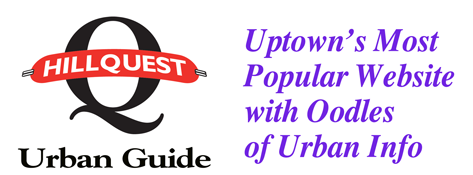This multi-hour hike begins on University Avenue, the primary east/west corridor through our commercial district. We will wend our way through Hillcrest, Cypress Canyon, Balboa Park and into Bankers Hill. Sites along the way include historic buildings, bridges and canyons (wear walking shoes). Follow along the pink line with orange identifying numbers on HillQuest’s printable maps . Take water and a snack on your adventure. Along the way, please support HillQuest advertisers!
The entire six-mile walk is moderately strenuous with hills. Consult the maps (759k PDF) if you would rather stay on surface streets. It may also be divided into shorter strolls.
 1. Hillcrest Sign. Let’s start at the corner of Fifth and University in the heart of the neighborhood. The pink neon landmark, donated to the neighborhood by local businesswomen in 1940, originally hung from wooden poles. The sign has seen several alterations over the decades including a rebuilding/relighting in 1984. The finials (post decorations) designed by Christopher Lee in 1994 proclaim this the “Hillcrest Gateway.” Just west another vintage neon sign marks Jimmy Wong’s Golden Dragon, the neighborhood’s oldest ongoing restaurant. It was remodeled in 2006 reopening as the Asian Bistro.
1. Hillcrest Sign. Let’s start at the corner of Fifth and University in the heart of the neighborhood. The pink neon landmark, donated to the neighborhood by local businesswomen in 1940, originally hung from wooden poles. The sign has seen several alterations over the decades including a rebuilding/relighting in 1984. The finials (post decorations) designed by Christopher Lee in 1994 proclaim this the “Hillcrest Gateway.” Just west another vintage neon sign marks Jimmy Wong’s Golden Dragon, the neighborhood’s oldest ongoing restaurant. It was remodeled in 2006 reopening as the Asian Bistro.
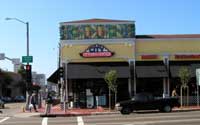 2. Kahn Building. Constructed in 1919 at the height of the Egyptian Revival, this large structure begins with CinRix and runs all the way to Sixth Avenue. The frieze atop City Deli originally featured pharaohs until the present cornucopia was added following a fire in 1921. The colorfully painted fruit and vegetables were initially covered in gold leaf. The City Deli space has continuously housed a restaurant for more than 83 years. The Cardini family had the longest run with Caesar’s from 1923-1972. Current owners, Alan Bilmes and Mike Wright have operated the popular deli since 1984.
2. Kahn Building. Constructed in 1919 at the height of the Egyptian Revival, this large structure begins with CinRix and runs all the way to Sixth Avenue. The frieze atop City Deli originally featured pharaohs until the present cornucopia was added following a fire in 1921. The colorfully painted fruit and vegetables were initially covered in gold leaf. The City Deli space has continuously housed a restaurant for more than 83 years. The Cardini family had the longest run with Caesar’s from 1923-1972. Current owners, Alan Bilmes and Mike Wright have operated the popular deli since 1984.
3. Sidewalk fossils. Neighborhood artist Doron Rosenthal created 150 of these “fossils” as a 1998 public art project. Made from recycled stone they’re imbedded in on both sides of University from First to Park Boulevard. How many can you locate?
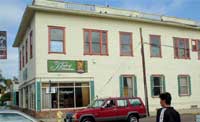 4. House of Heirlooms. St. Joseph’s Hospital (the forerunner to Scripps/Mercy Hospital) occupied this building (see page 133 of HillQuest volume 4) from 1891 to 1924. The wooden structure was originally erected in 1919 as a surgery annex. Note the springs on the west side door. These provided protection as the ambulances backed up to unload. Early lodging for the nursing school still survives in the hotels just to the north on Eighth Avenue behind Jack in the Box.
4. House of Heirlooms. St. Joseph’s Hospital (the forerunner to Scripps/Mercy Hospital) occupied this building (see page 133 of HillQuest volume 4) from 1891 to 1924. The wooden structure was originally erected in 1919 as a surgery annex. Note the springs on the west side door. These provided protection as the ambulances backed up to unload. Early lodging for the nursing school still survives in the hotels just to the north on Eighth Avenue behind Jack in the Box.
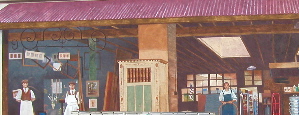
5. Ace Hardware Mural. As you cross Tenth Avenue enjoy the mural depicting a yesteryear hardware store. Artist Linda Churchill created “The Loading Dock” in 1999.

6. Hillcrest Streetscape Project. Check out the new sidewalk improvements over the next few blocks. The first phase, the landscaped median along University from Tenth east to Normal, was completed over a decade ago. In 2006 two blocks of new sidewalks, streetlamps and pop-outs on the south side of University Avenue between Vermont and Herbert were finished. This was phase two of a $1.6-million master plan. The final phase (the Normal Street median project) is scheduled for completion within the next few years.
7. John Wear Memorial. Locate this bronze plaque near the curb in front of Obelisk Bookstore. In 1991 this teen was chased down and killed because his assailants thought he was gay. The community is dedicated to ending hatred and violence on our streets.
8. Uptown District. Across University Avenue is the neighborhood’s first mixed-use project with a variety of retail stores and 318 residential units. In 1986, the city purchased the 14-acre abandoned Sears store and surrounding parking lot for $9 million. Originally planned to be the new central library, the City Council decided to revitalize the area with additional housing and retail. (Sears, Roebuck & Co. operated here from October 15, 1952 until March 15, 1986.)
9. Along the way to. Trolleys once ran down the middle of University Avenue and north on Normal Street to the teaching school (see article on the Hillcrest History Guild website).
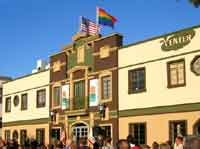 9. The LGBT Center. Spot the flags on the building across the street? The former union hall now bustles with energy and social services. The Center, home base to San Diego’s lesbian, gay, bisexual and transgender community since 1999, was founded in 1971 (by Jesse Jessop).
9. The LGBT Center. Spot the flags on the building across the street? The former union hall now bustles with energy and social services. The Center, home base to San Diego’s lesbian, gay, bisexual and transgender community since 1999, was founded in 1971 (by Jesse Jessop).
10. Marquis Apartments. Originally named Churchill Apartments (then the multi-colored Casa Grande Apartment) this building was first used as lodging for the first exposition in Balboa Park.
 11. The Egyptian Block. Before rounding the corner, look ahead to the parabolic arch (Georgia Street Bridge) that in 1914 allowed expansion into North Park. This bustling intersection was home to the Bush Egyptian Theatre in 1923. Throughout the years it underwent subsequent name changes including the Fox Egyptian, the Capri and the Park. The original facade now painted tan is all that remains. Step to the curb and look over the pillars to view the frieze. It is surrounded by the first of Park Boulevard’s modern mixed-use developments, aptly named the Egyptian. Next door, The Cairo is also named in the flavor of the original neighborhood. Several remaining treasures still occupy this block. Enjoy discovering King Tut’s relatives as you stroll. How many can you find?
11. The Egyptian Block. Before rounding the corner, look ahead to the parabolic arch (Georgia Street Bridge) that in 1914 allowed expansion into North Park. This bustling intersection was home to the Bush Egyptian Theatre in 1923. Throughout the years it underwent subsequent name changes including the Fox Egyptian, the Capri and the Park. The original facade now painted tan is all that remains. Step to the curb and look over the pillars to view the frieze. It is surrounded by the first of Park Boulevard’s modern mixed-use developments, aptly named the Egyptian. Next door, The Cairo is also named in the flavor of the original neighborhood. Several remaining treasures still occupy this block. Enjoy discovering King Tut’s relatives as you stroll. How many can you find?
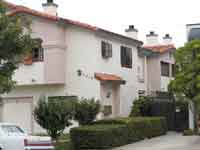 12. 1234 Robinson Avenue. Hillcrest resident and gay gigolo Andrew Cunanan lived here before going on his nationwide killing spree in 1997. After murdering five men including famed designer Gianni Versace, he committed suicide on a houseboat in Miami.
12. 1234 Robinson Avenue. Hillcrest resident and gay gigolo Andrew Cunanan lived here before going on his nationwide killing spree in 1997. After murdering five men including famed designer Gianni Versace, he committed suicide on a houseboat in Miami.
.on the way to #13 look for “Pennsilvania.”
13. Dan Broderick House. In 1989 this stately colonial is where Betty Broderick murdered her ex and his new wife as they slept. She sneaked in via the back door. To the left of the front door you can see the replaced brickwork from a previous visit (when she entered with her van).
14. Cypress Canyon. Leave the paved street and head down the dirt road into the canyon. Listen and watch for birds in this beautiful urban paradise. Follow the creek bed to the right toward highway 163. After crossing the Upas Street pedestrian bridge (aka horse bridge) walk up the concrete sidewalk to a grove of lemon-scented eucalyptus trees on the edge of Balboa Park.
 15. Marston House. Preserved by the San Diego Historical Society and now open to the public. Irving Gill designed this home for George Marston’s family. “San Diego’s First Citizen” loved ice skating and was still at it at the age of 90. The beautiful grounds surrounding the house are worth exploring.
15. Marston House. Preserved by the San Diego Historical Society and now open to the public. Irving Gill designed this home for George Marston’s family. “San Diego’s First Citizen” loved ice skating and was still at it at the age of 90. The beautiful grounds surrounding the house are worth exploring.
Note: from here you may return to Hillcrest by jumping to #28
16. Roque Courts. These long-abandoned courts need use. Wanna learn how to play? Contact the gals at HillQuest. Continue meandering through the Healing Garden, “Balboa Beach” and Redwood Circle (a great place for a picnic).
17. Lawn Bowling Courts. If you’re lucky enough to catch a game in progress, sit and watch this interesting sport. What they’re rolling is called a “bowl” that is heavier on one side, so it naturally curves to the weighted side as it slows. The goal is be the closest to the small white “jack.” Contact club members at (619) 238-5457 for free lessons.

18. San Diego Pioneers. Kate Sessions (on the south) and the trio of Alonzo Horton, Ephraim Morse and George Marston were sculpted and cast in bronze by San Diegan Ruth Hayward. The boys have benches perfect to rest and read HillQuest in the company of historic leaders before continuing your journey.
19. Palomar Apartments. Designed by architects Frank Mead and Richard Requa, this 1904 two-tone pink apartment house can boast, “Charles Lindbergh slept here” prior to his historic flight to Paris.
20. St. Paul’s Cathedral. Philip Frohman who designed DC’s National Cathedral also gets credit for this lovely Episcopal church. Planned in 1928, the Great Depression and subsequent problems postponed the first church service until 23 years later.
On the way to #21 can you hear the airport? Several large developments are planned for this area over the next several years. Stay tuned.
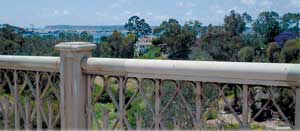 21. First Avenue Bridge. This great span was erected in 1931 at the instigation of property owners under the Improvement Act of 1911. “People’s bridge” offers a great viewing platform for San Diego Harbor and Maple Canyon.
21. First Avenue Bridge. This great span was erected in 1931 at the instigation of property owners under the Improvement Act of 1911. “People’s bridge” offers a great viewing platform for San Diego Harbor and Maple Canyon.
Want more? On your way to #22 consider taking a side trip east two blocks on Quince Street to the 1905 wooden trestle pedestrian bridge over Maple Canyon. A trailhead into San Diego’s best urban canyon can be found nestled in the eucalyptus trees along Third Avenue.
22. Self Realization Fellowship. This tranquil retreat founded by Paramahansa Yogananda. This site was first designed in 1908 for the Bishop’s Day School.
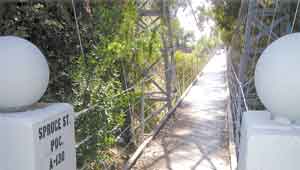 23. Spruce Street Bridge. The best known “secret” in 92103 is this 1912 suspension bridge, the only one in the county. The footpath floats among treetops, gracefully suspended from two steel cables anchored to concrete piers at either end. The lightness of the bridge allows it to sway and dance in response to wind and walkers. Enjoy!
23. Spruce Street Bridge. The best known “secret” in 92103 is this 1912 suspension bridge, the only one in the county. The footpath floats among treetops, gracefully suspended from two steel cables anchored to concrete piers at either end. The lightness of the bridge allows it to sway and dance in response to wind and walkers. Enjoy!
On the way to #24 enjoy the architecture. Seven of the oldest are located at 435 W Spruce (1913, Mead & Requa), 3170 Curlew (1912, Hazel Waterman), 3226 Curlew (1912, William Hebbard) and four between 3353-3367 Albatross (1912 & 1913, Irving Gill).
24. Letitia Lovett House. Turn the corner to view this grand Victorian built circa 1980 on the Fourth Street cable car line. Letitia saved her home from the wrecking ball by rolling it downhill to the current location.
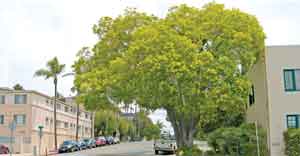 25. Kate Sessions Tree. Rumored to be one of her favorites, the sidewalk now gives way to this grand camphor tree. The city moved the sidewalk to create a petite park on this busy thoroughfare.
25. Kate Sessions Tree. Rumored to be one of her favorites, the sidewalk now gives way to this grand camphor tree. The city moved the sidewalk to create a petite park on this busy thoroughfare.
26. Second & Thorn. Locate the spelling error in the concrete.
On the way to #27 you’ll pass the location (SW corner of Fourth and Spruce) where in 1890 the steam engines were housed for the cable cars. One block more you’re at Jimmy Carter’s, the cafe with the area’s most diverse menu.
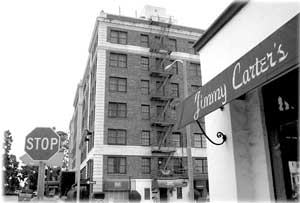 27. Park Manor Suites. Built in 1926 the history of this hotel includes child actor Jackie Coogan’s family, who used some of his earnings to invest in this seven-story Italian Renaissance style structure. Frank Allen who supervised buildings for the 1915 Panama-California Exposition designed the hotel. The top floor offers a wonderful panorama of the park, harbor and Hillcrest! It sold in 2011 to become time-shares.
27. Park Manor Suites. Built in 1926 the history of this hotel includes child actor Jackie Coogan’s family, who used some of his earnings to invest in this seven-story Italian Renaissance style structure. Frank Allen who supervised buildings for the 1915 Panama-California Exposition designed the hotel. The top floor offers a wonderful panorama of the park, harbor and Hillcrest! It sold in 2011 to become time-shares.
28. Mi Arbolito. Referred to as “The Hole” by neighbors, the development broke ground in 2004. The footprint was designed for 14 stories with one residence per floor. The neighbors at 666 Upas were successful keeping the developer at bay until 2006. But now the concrete structure throws shadows on the NW entrance to Balboa Park, San Diego’s most precious jewel.
29. The Wednesday Club. Founded in 1893 by a small group of women interested in literature and art. Architect (and member) Hazel Waterman designed the building in 1910. She was also the mother of Waldo, an early aviator in Maple Canyon, and the daughter-in-law of a California governor. The Wednesday Club’s first meeting place is block and a half north — the old Dartlee Hall (see HQ5).
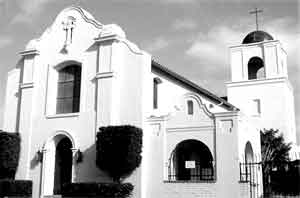
30. All Saints’ Episcopal Church. Established in 1897, this is Hillcrest oldest church. Designed by the team of William Hebbard and Carleton Winslow in 1912. From 2004-2001 is was home to Hillcrest’s “Aussie priest.”
On the way to #31 step into The Lily Pad and browse their unique toy collection for children of all ages.
31. Brass Rail. You’re done! Celebrate with a cocktail at Hillcrest’s first gay bar which was originally located across the street where Chase bank now stands. Tell them HillQuest sent you — or better yet…give a call, and we’ll join you.
